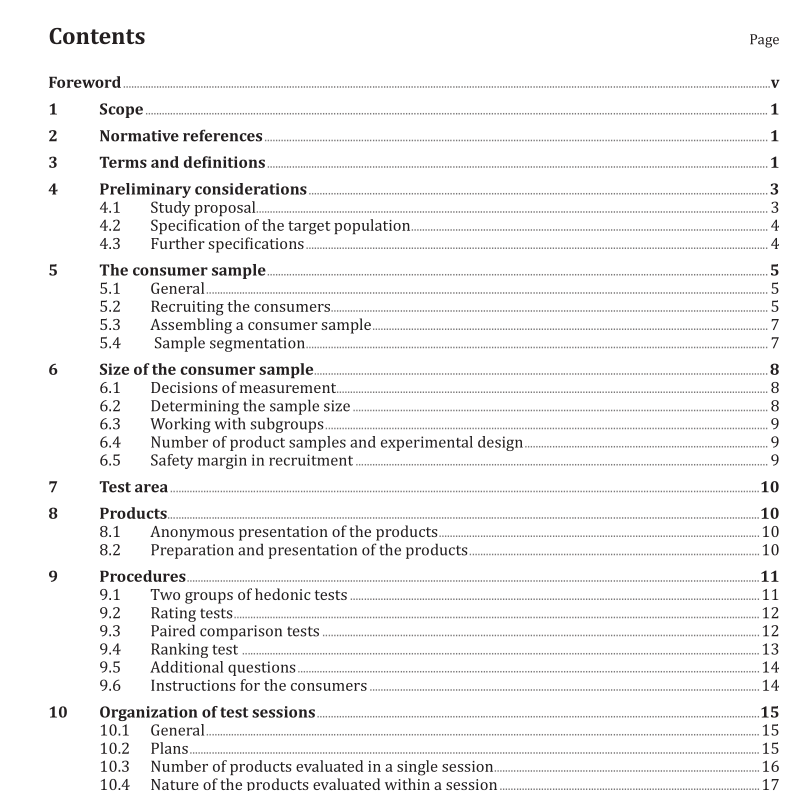ISO 11136 pdf download

ISO 11136 pdf download Sensory analysis — Methodology — General guidance for conducting hedonic tests with consumers in a controlled area
1 Scope
This International Standard describes approaches for measuring, within a controlled area, the degree towhich consumers like or relatively like products.
lt uses tests based on collecting consumers’responses to questions, generally on paper or via a keyboardor a touch screen. Tests of a behavioural nature (such as recording quantities consumed ad libitum bythe consumers) do not fall within the scope of this International Standard.
The hedonictests dealt with in this InternationalStandard, can be used as a contribution to the followingcomparing a product with competitor products;
optimizingaproductso thatitobtains ahigh hedonic rating oris liked bvalarge numberofconsumers
helping to define a range of products to correspond to a particular consumer target population;
helping to define a best-before date;
assessing the impact of a product formulation change on the pleasure given by the product;
studying the impact of sensory characteristics of a product on degree to which it is liked,independently ofthe product’s extrinsic characteristics, such as brand, price, or advertising
studying the effect ofa commercial or presentation variable, such as packaging
The methods are effective for determining
– whether or not, a perceptible preference exists (difference in degree of liking), orwhether or not, no perceptible preference (paired similarity test) exists.
2 Normative references
The following documents, in whole or in part, are normatively referenced in this document and areindispensable for its application. For dated references, only the edition cited applies. For undatedreferences, the latest edition of the referenced document (including any amendments) applies.
ISO 4121, Sensory analysis – Guidelines for the use of quantitative response scales
ISO 5492, Sensory analysis – Vocabulary
ISO 5495, Sensory analysis – Methodology – Paired comparison test
ISO 8587,Sensory analysis – Methodology – Ranking
ISO 8589, Sensory analysis — General guidance for the design oftest rooms
ISO 29842, Sensory analysis – Methodology – Balanced incomplete block designs
3.1
access panel
sample database of potential respondents who declare that they will cooperate for future datacollection if selected
SOURCE:ISO 20252]
Note 1 to entry: Respondents can be drawn on a more or less regular basis.
3.2
closed-ended questionquestion requiring respondents to select from a predetermined list of possible answers
3.3
commissioning party
person, body, or service who commissions a third party to conduct a study
Note 1 to entry: The concept of commissioning party corresponds to that of purchaser or customer in qualitycontrol. It contrasts with that of the supplier, service provider, or laboratory
Note 2 to entry: Usually, the commissioning party and the service provider belong to different enterprises. Wherethey belong to two departments of the same enterprise, the respective responsibilities of the two departmentsshall be carefullv differentiated and explicitly clarified in the study proposal
3.4
consumer
respondent
person who uses a product
Note 1 to entry: For the purposes of this lnternational Standard, the meaning is restricted to a person who isneither an expert,an expert sensory assessor nor a selected assessor in conformity with ISO 5492.
3.5
consumer sample
group of consumers recruited on the basis of criteria specified by the nature of the target population
3.6
controlledarea
location providing
controlled preparation and presentation of the products
comfortable conditions for consuming the products and for guestioning the consumers. andabsence of communication (verbal and non-verbal) between the consumers, guaranteeingindependent responses









